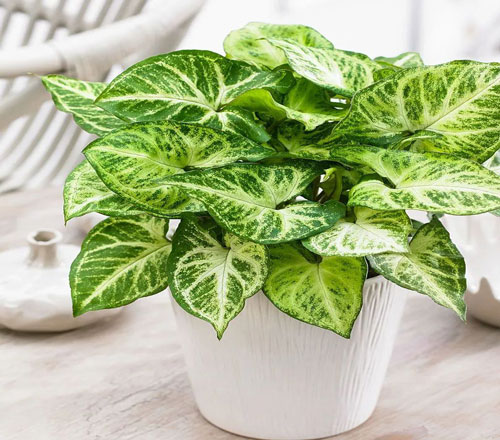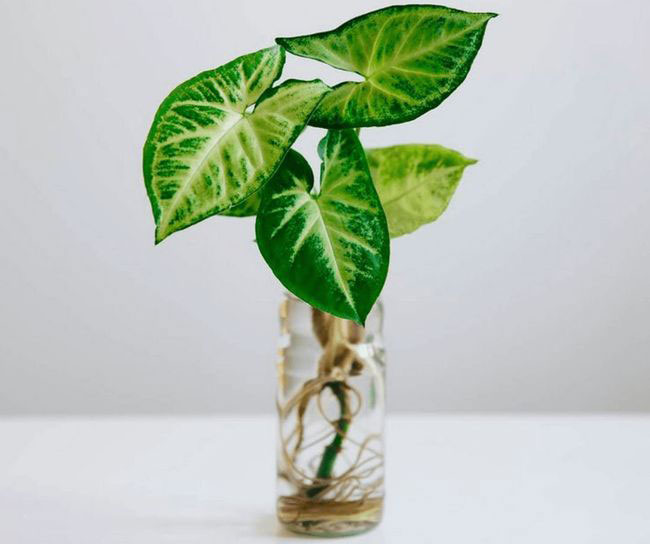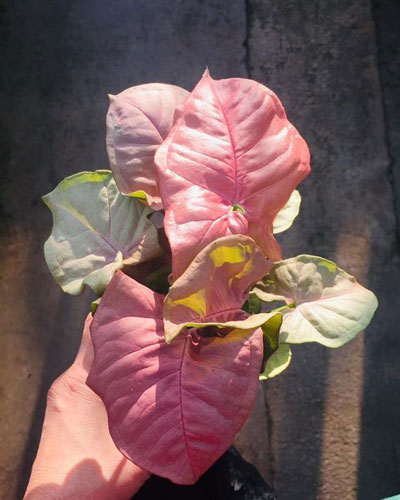Arrowhead Plant (Syngonium Podophyllum) Care & Propagation Guide
Written by Iris
Dec 09 2021
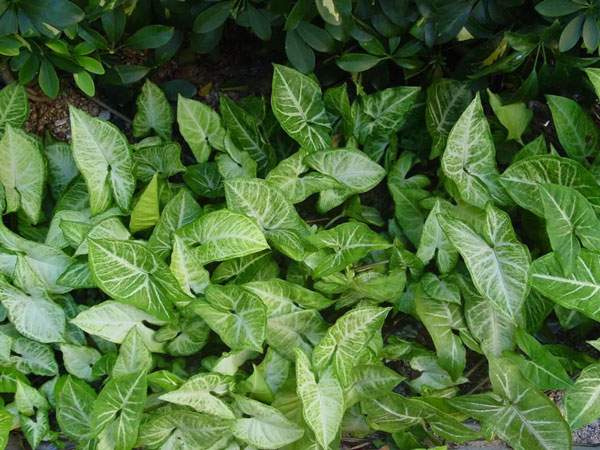
You may know of arrowhead vine by one of its other various names, such as five fingers, American evergreen, nephthytis, or goosefoot vine. A species of ariod from the Araceae family, arrowhead plant (Syngonium Podophyllum) hails from a large chunk of Latin America and has been naturalized in the US and in the West Indies, most popularly grown as a houseplant. Like most vines, it will creep along a support if one is provided as it reaches maturity, otherwise it acts much like a ground cover plant, making it well suited for containers, as well as indoor trellis ideas. Arrowhead vine is lovely in container or hanging basket by itself, or with a companion plant. Most Arrowhead Plants have variegated leaves that evolve as the plant matures from a simple arrow shaped structure, into a divided, long-lobed leaf. Learn how to grow and care for Arrowhead Plants with important tips.
Arrowhead Plants have multiple indoor uses and grow well planted in hanging baskets allowing the stems to cascade over the side, in regular pots, or used with a moss stick or indoor trellis system allowing the stems to crawl upward. Just make sure the container has bottom drain holes so the soil doesn't remain too soggy. (Find more best indoor hanging plants here.)
However, as they are so resilient, arrowhead plant propagation can be done at most times of the year with a reasonable success rate. This is also possible if you propagate with stem cuttings in winter, but often takes longer.
Stem cuttings are simply pieces of stem that are cut off from the parent plant and then used to grow a new plant. The essential thing is to make your cut below a node and to have at least one leaf already formed on the piece of stem that you remove from the original plant.
A node is a joint in the stem which you will easily be able to recognize as it creates two bumps on opposite sides of the stem. Left to its own devices, the arrowhead plant would eventually produce aerial roots from these nodes and they would aid the plant in climbing.
Make your cut just below this node as it is from the node that the first roots of your new plant will begin to appear in 1-2 weeks. It is important that you make you cut close to the node as any excess stem material is at risk of dieback and this could lead to disease.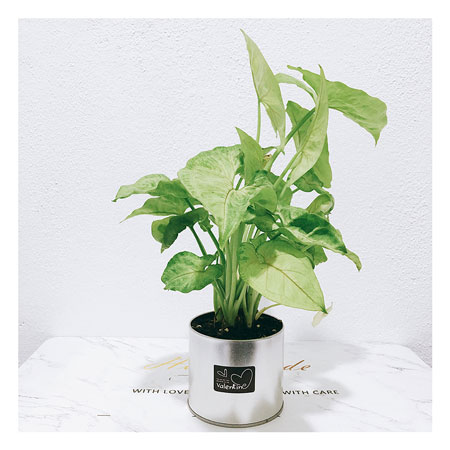
The first one in propagating Arrowhead Plant in water. Simply popping the cutting into a glass of water is probably the most common method. The node will need to always remain below the surface of the water with the leaves hanging on the lip of the glass or whatever container you choose to use.
Plant growers who take a lot of cuttings often use glass test tubes that can stand in a rack so that they can root many cuttings at once.
You won't need to go to this expense and even if you want to root several cuttings at once you can do so by just popping them into the same glass of water. After one to two weeks, you will notice that the nodes are starting to produce small white roots.
This is a sign that all is going to plan but it is not yet an indication that your arrowhead cutting is ready to be potted up. It will take a few more weeks before the root system is strong enough to be planted into a pot.
Other than monitoring the root growth and making sure that the water level is always topped up, you won’t need to do much at this stage. Be aware, though, that as the plant develops it will consume water more quickly so keep an eye on that water level. (Find more Vine Plants Indoor here.)
It can help when planting cuttings into soil to use a rooting hormone to improve root development. Personally, I prefer being able to monitor root development as the roots grow in the water.
It is best to plant at least 4-6 cuttings into each pot, as this will give your Arrowhead plant a full and bushy growth habit and make for a really impressive plant.
It is ok to plant your cuttings directly into whatever pot you plan to keep them in. Try to keep the soil lightly moist during the first few weeks of growth. This will prevent your arrowhead plant cuttings from wilting and help them establish faster.
It also helps to keep humidity high, and place the pot in bright, indirect light. Excessive direct sunlight will cause your cuttings to wilt, while low light will negatively impact their growth. (Read more about propagating arrowhead plant.)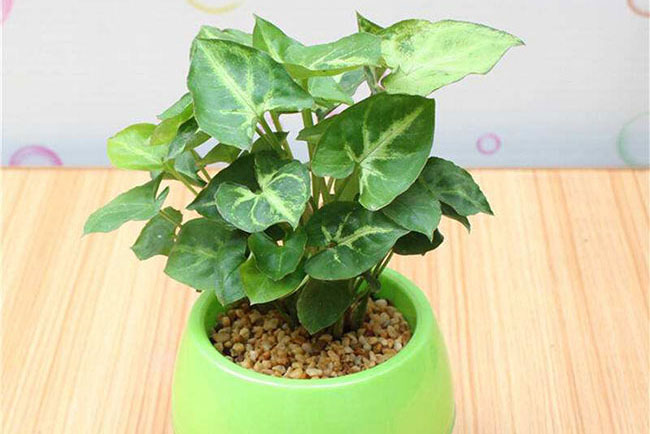
Tropical in nature, arrowhead plants are perfect for a sunroom or greenhouse conservatory where ample heat, light, and humidity will encourage their growth. Provide your arrowhead plant with the right growing conditions, and you will have a lush and healthy plant.
When growing vigorously, appropriate bud pruning for arrowhead plant is necessary. Mainly cut off the new buds and some overlapping branch buds, in order to avoid the consumption of nutrition, which will affect the growth of the arrowhead plant.
Neon Robusta
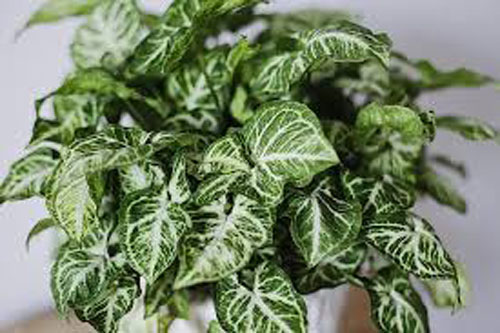
Syngonium Imperial White
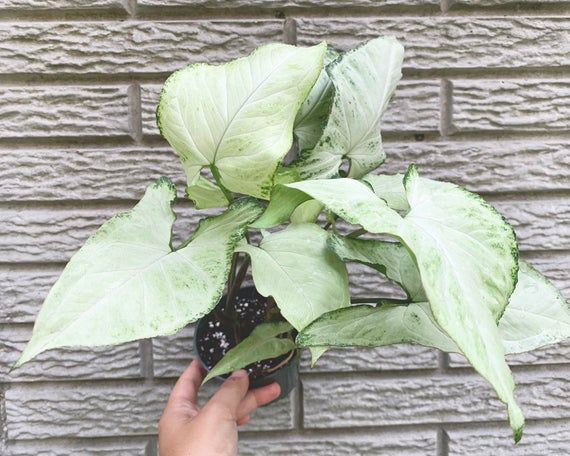
Holly Syngonium
Poisoning Symptoms:
Ingestion can cause burning sensation of throat, numbness of mouth and tongue, edema, salivation, mouth opening difficulties and other symptoms.
Poisoning Treatment:
Most symptoms will be alleviated over time until disappear. If you want to relieve the pain, you can choose cool liquid, pain pills or licorice and flaxseed food. Drink more water, sweat more, urinate more. Seek medical advice if you feel particularly unwell. (Read more about Arrowhead Plant Toxic.)
Tips:
20 Popular Vine Plants Indoor To Grow
How To Take Care Of Pink Syngonium
Are Arrowhead Vines Safe for Cats
How to Propagate Arrowhead Plant
Why My Arrowhead Plant Turning Yellow And Drooping
6 Kinds of Arrowhead Plant Varieties With Pictures
Where to Grow Arrowhead PlantsWhen to Grow Arrowhead PlantsArrowhead Plants PropagationArrowhead Plants Propagation In Water Arrowhead Plants Propagation In SoilArrowhead Plants CareArrowhead Plants Light CareArrowhead Plants Soil CareArrowhead Plants Water CareArrowhead Plants Temperature & Humidity CareArrowhead Plants Fertilizer CareArrowhead Plants Pruning CareArrowhead Plants Pests & Diseases CareArrowhead Plant VarietiesSyngonium podophyllum 'Pink Allusion'Syngonium podophyllum 'Neon Robusta'Syngonium podophyllum 'Imperial White'Syngonium podophyllum 'Holly Syngonium'Arrowhead Plant Care FAQsWhy Are Arrowhead Plant Leaves Turning Yellow and Drooping?Why are Brown Tips Appearing on Arrowhead Plant Leaves?How to Speed Up Arrowhead Vine Growth?Is Arrowhead Plant Toxic to Cats
Where to Grow Arrowhead Plants
Arrowhead plant thrives outdoors in hardy USDA areas and has a wide distribution in warm tropical regions around the globe. In cooler climates, it is usually grown indoors. Provided the right growing environment, Arrow plants will thrive and thrive in an indoor environment. Arrow plants usually prefer bright light but do not like direct sunlight. Under the eaves of a garden or by an indoor window are good choices. Dark green Arrowhead Plants enjoy the partial shade, while arrowhead vines with variegated leaves can withstand a little direct sunlight.Arrowhead Plants have multiple indoor uses and grow well planted in hanging baskets allowing the stems to cascade over the side, in regular pots, or used with a moss stick or indoor trellis system allowing the stems to crawl upward. Just make sure the container has bottom drain holes so the soil doesn't remain too soggy. (Find more best indoor hanging plants here.)
When to Grow Arrowhead Plants
The best time to plant Arrowhead Plants is in the spring, summer and fall because the roots grow faster in warmer weather, and the plant will be growing strongly at this time and the cuttings will establish themselves quickly.However, as they are so resilient, arrowhead plant propagation can be done at most times of the year with a reasonable success rate. This is also possible if you propagate with stem cuttings in winter, but often takes longer.
Arrowhead Plants Propagation
To make more arrowhead vines, propagate Arrowhead Plants from stem cuttings, which are best taken in the late spring and early summer. An Arrowhead plant can be propagated from cuttings in either water or soil. Cut a 6-12 inch section of the stem just below a node. Plant in moist soil or put the stem directly in water. New roots will appear within 1-2 weeks and new leaves after about 4 weeks. Here are details on how to propagate Arrowhead plants.Stem cuttings are simply pieces of stem that are cut off from the parent plant and then used to grow a new plant. The essential thing is to make your cut below a node and to have at least one leaf already formed on the piece of stem that you remove from the original plant.
A node is a joint in the stem which you will easily be able to recognize as it creates two bumps on opposite sides of the stem. Left to its own devices, the arrowhead plant would eventually produce aerial roots from these nodes and they would aid the plant in climbing.
Make your cut just below this node as it is from the node that the first roots of your new plant will begin to appear in 1-2 weeks. It is important that you make you cut close to the node as any excess stem material is at risk of dieback and this could lead to disease.

Arrowhead Plants Propagation In Water
As you are about to see, Arrowhead plant propagation is really easy and you have two options when it comes to rooting your cuttings.The first one in propagating Arrowhead Plant in water. Simply popping the cutting into a glass of water is probably the most common method. The node will need to always remain below the surface of the water with the leaves hanging on the lip of the glass or whatever container you choose to use.
Plant growers who take a lot of cuttings often use glass test tubes that can stand in a rack so that they can root many cuttings at once.
You won't need to go to this expense and even if you want to root several cuttings at once you can do so by just popping them into the same glass of water. After one to two weeks, you will notice that the nodes are starting to produce small white roots.
This is a sign that all is going to plan but it is not yet an indication that your arrowhead cutting is ready to be potted up. It will take a few more weeks before the root system is strong enough to be planted into a pot.
Other than monitoring the root growth and making sure that the water level is always topped up, you won’t need to do much at this stage. Be aware, though, that as the plant develops it will consume water more quickly so keep an eye on that water level. (Find more Vine Plants Indoor here.)
Arrowhead Plants Propagation In Soil
Some growers prefer to plant arrowhead plant cutting directly into soil. This propagation method is equally effective and it comes down to personal choice as to which method you opt for. Those that plant directly into the pot point out that this eliminates any chance of shock as the plant is potted up.It can help when planting cuttings into soil to use a rooting hormone to improve root development. Personally, I prefer being able to monitor root development as the roots grow in the water.
It is best to plant at least 4-6 cuttings into each pot, as this will give your Arrowhead plant a full and bushy growth habit and make for a really impressive plant.
It is ok to plant your cuttings directly into whatever pot you plan to keep them in. Try to keep the soil lightly moist during the first few weeks of growth. This will prevent your arrowhead plant cuttings from wilting and help them establish faster.
It also helps to keep humidity high, and place the pot in bright, indirect light. Excessive direct sunlight will cause your cuttings to wilt, while low light will negatively impact their growth. (Read more about propagating arrowhead plant.)

Arrowhead Plants Care
Arrowhead plant is a relatively easy houseplant to care for—it will thrive under the same conditions as its very popular relative, the philodendron. Arrowhead vines are climbers in the wild and will eventually grow from shade into full sun in the canopy of trees, with leaves maturing and gaining size as the plants gain altitude. As a houseplant, they're often used as trailing plants once mature and can be trained up a pole or moss stick for added visual interest. Alternately, you can pinch new growth to maintain the young plant's upright stems.Tropical in nature, arrowhead plants are perfect for a sunroom or greenhouse conservatory where ample heat, light, and humidity will encourage their growth. Provide your arrowhead plant with the right growing conditions, and you will have a lush and healthy plant.
Arrowhead Plants Light Care
Arrowhead vine plant likes bright light but no direct sun. Diffused light is best, as harsh rays can burn or bleach the delicate leaves and vines. Variegated colorways can handle a bit more direct sun, while deeper green varieties are better adapted to partial shade.Arrowhead Plants Soil Care
Plant your arrowhead plant in a traditional soil-based potting mix. Arrowhead plants are prone to root rot, so you'll want to make sure whichever potting soil you choose is well-draining. Additionally, consider planting your vine in a terracotta or clay vessel to wick away extra moisture from the soil.Arrowhead Plants Water Care
Water your arrowhead vine regularly during the spring and summer months, and reduce your watering cadence come winter. During the spring and summer, you want to allow your vine to dry out partially between waterings but never completely. Likewise, the plant should not be kept too wet, either.Arrowhead Plants Temperature & Humidity Care
True to its tropical nature, arrowhead plant prefers warm and humid conditions. If possible, maintain temperatures above 60 degrees Fahrenheit. While the plant can tolerate average humidity, it will thrive best with added moisture in the air. Consider keeping your arrowhead plant somewhere in your home with naturally higher humidity (like a kitchen or bathroom), or utilize a method of increasing humidity, like a portable machine or placing a bed of wet river rocks beneath the pot.Arrowhead Plants Fertilizer Care
Feed your arrowhead vine once a month with liquid fertilizer throughout the spring, summer, and fall months when growing Arrowhead Plant. You can halt feeding throughout winter when the plant will naturally slow its growth.Arrowhead Plants Pruning Care
Appropriate pruning of Arrowhead Plants in different growth periods will be conducive to the growth of the plant. The Arrowhead Plants grows faster in the abundant environment of fertilizer and water, at this time should be given timely pruning treatment. Cut off the branches that will not conform to the shape, in order to maintain the beauty of the plant shape and concentrate the nutrients in the main branches.When growing vigorously, appropriate bud pruning for arrowhead plant is necessary. Mainly cut off the new buds and some overlapping branch buds, in order to avoid the consumption of nutrition, which will affect the growth of the arrowhead plant.
Arrowhead Plants Pests & Diseases Care
Arrowhead plant is relatively resistant to pests on their own. However, dwelling in the home amongst other plants can expose it to pests like spider mites, mealybugs, aphids, and scale. If you notice any of these afflictions, treat your plant immediately with neem oil or another natural solution.Arrowhead Plant Varieties
Let's look briefly at some of the most popular Arrowhead Plant varieties that grow exceptionally well indoors:Syngonium podophyllum 'Pink Allusion'
Syngonium podophyllum 'Pink Allusion' - a variety of arrowhead plant that has shiny green leaves with hints of pink blushing and pink veins. (Read more about pink arrowhead plant care.)Syngonium podophyllum 'Neon Robusta'
Another cultivar with rosy-pink and green foliage which is very easy to care for and looks stunning in any home decor.
Neon Robusta
Syngonium podophyllum 'Imperial White'
This stunning variety has variegated leaves that are dark green and brilliant white. It's one of the rarest types of arrowhead plant you can find and similar to the 'Albo-Variegatum' cultivar.
Syngonium Imperial White
Syngonium podophyllum 'Holly Syngonium'
Also called Holly Nephthytis, this arrowhead plant has spectacular white leaves with green edging.
Holly Syngonium
(Read more about arrowhead plant varieties.)
Arrowhead Plant Care FAQs
Why Are Arrowhead Plant Leaves Turning Yellow and Drooping?
Watering issues are usually to blame if your arrowhead plant leaves start yellowing and arrowhead plant drooping. Too much water or not enough hydration can cause the syngonium plant's vibrant foliage to become yellow. Check the soil for moisture levels and adjust your watering schedule appropriately. (Read more about saving yellow and drooping Arrowhead Plant.)Why are Brown Tips Appearing on Arrowhead Plant Leaves?
A lack of humidity can result in brown patches on the Syngonium leaves. To resolve the issue, bump up the humidity levels around the plant. Also, make sure that the arrowhead plant isn’t near air vents or radiators.How to Speed Up Arrowhead Vine Growth?
Naturally, Arrowhead Plants grow slower in the winter. However, if their growth seems lethargic during the growing season, you need to check your care methods. Try moving the Syngonium plant container to a brighter spot and humidify regularly. You could also try repotting the syngonium podophyllum plant to replenish nutrients and feed with a balanced household fertilizer monthly during the growing season.Is Arrowhead Plant Toxic to Cats
Arrowhead plant is toxic to humans and cats.Poisoning Symptoms:
Ingestion can cause burning sensation of throat, numbness of mouth and tongue, edema, salivation, mouth opening difficulties and other symptoms.
Poisoning Treatment:
Most symptoms will be alleviated over time until disappear. If you want to relieve the pain, you can choose cool liquid, pain pills or licorice and flaxseed food. Drink more water, sweat more, urinate more. Seek medical advice if you feel particularly unwell. (Read more about Arrowhead Plant Toxic.)
Tips:
- If there are children or pests in the family, it is not recommended to grow arrowhead plants
- Do not touch, never try to eat arrowhead plant. Avoid the juice splashing into eyes, mouth, nose, etc.
- When caring for arrowhead plant, it is suggested wearing gloves to handle the plant or thoroughly wash your hands afterwards.
20 Popular Vine Plants Indoor To Grow
How To Take Care Of Pink Syngonium
Are Arrowhead Vines Safe for Cats
How to Propagate Arrowhead Plant
Why My Arrowhead Plant Turning Yellow And Drooping
6 Kinds of Arrowhead Plant Varieties With Pictures
Latest Updated
- Benefits of Bugleweed - 7 Science-backed Health Benefits
- Bugleweed Dangers & Side Effects - Is It Poisonous?
- How to Plant Evergreen Trees - What You Should Know
- When to Plant Evergreens - Grow Guide for Evergreen Trees
- 12 Wonderful Evergreen Shrubs for Your Garden
- 12 Popular Evergreen Plants with Pictures for Beginners
- When And How To Prune A Lilac Bush Like a Pro
- How to Grow & Care for Lilac Vine (Hardenbergia Violacea)
- Japanese Lilac Tree (Syringa Reticulata) Care & Propagation Guide
- Shumard Oak Pros and Cons - What to Know
Popular Articles
- Winter maintenance of Antirrhinum Majus
- How to Grow Terminalia Mantaly Tree
- How to Grow and Care for Crossostephium Chinense
- How to grow Antirrhinum Majus in spring
- Peristeria Elata (Dove Orchid) Profile: Info & Care Guide
- Underwatered Snake Plant (Sansevieria Trifasciata) - Signs And How To Fix
- How to Care for Brazilian Jasmine Plant (Mandevilla Sanderi)
- How to Grow & Care for Graptopetalum Purple Delight in Summer
- Rosa Chinensis (China Rose): Plant Growing & Care Tips
- How to Care for Baby Sun Rose (Aptenia Cordifolia)
